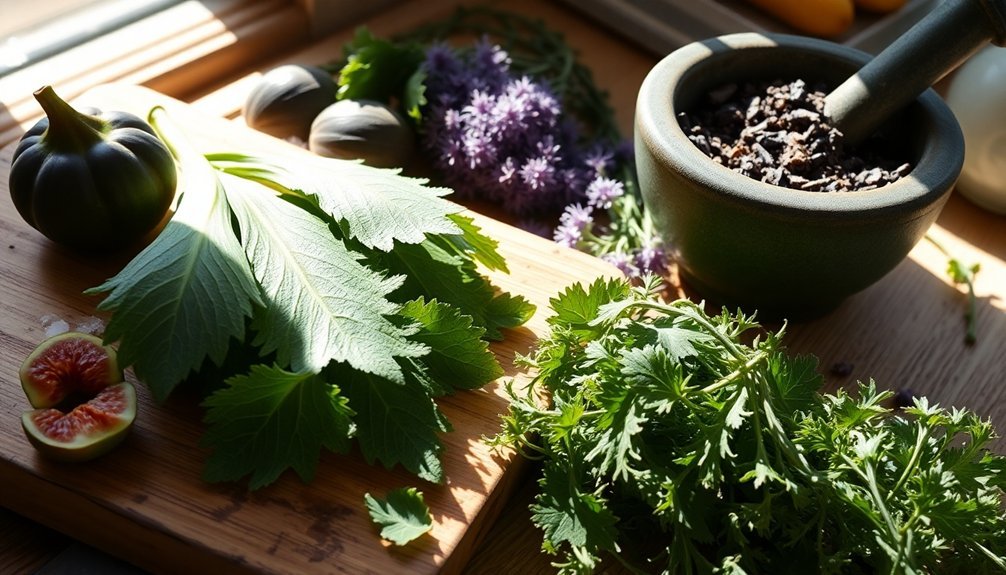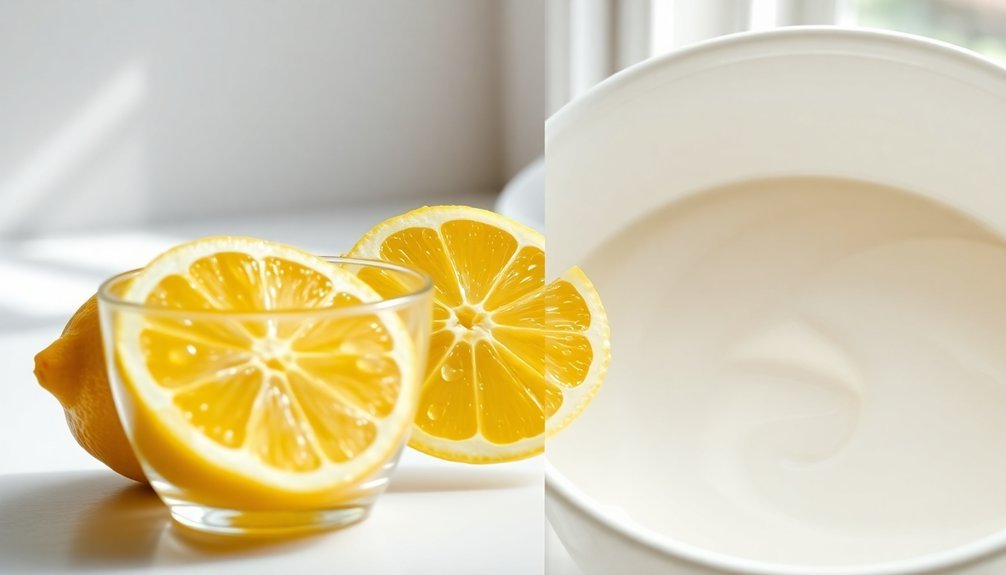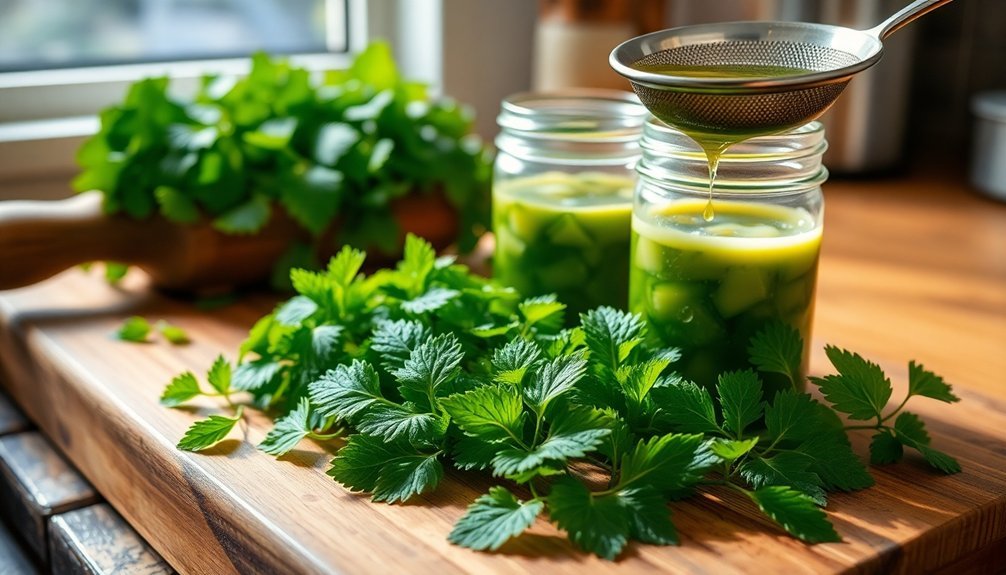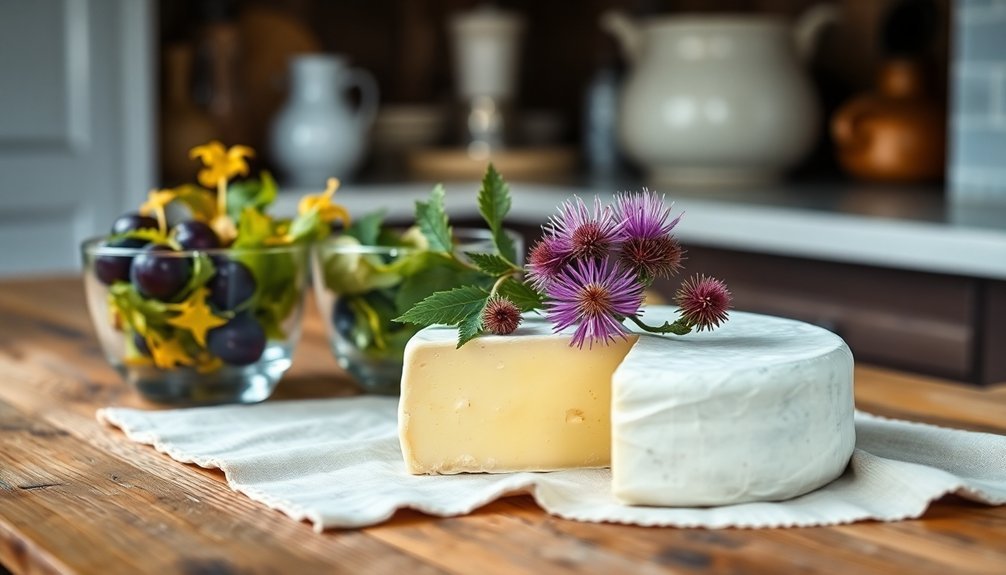You'll find several effective natural alternatives to rennet for cheese making. Plant-based options include nettle leaves (boiled and strained), wild thistle flowers (dried and ground), and fig tree sap (collected from green figs). You can also use acid-based coagulants like citric acid, fresh lemon juice, or distilled white vinegar, which work especially well for soft cheeses. Sorrel extract offers another plant-based choice, using about 5 teaspoons of juice per liter of milk. Each method requires specific preparation techniques and temperature controls to achieve the best results, and exploring these alternatives opens up a world of traditional cheese-making possibilities.
Plant-Based Cheese Coagulants

Discovering plant-based alternatives to traditional animal rennet opens up new possibilities for vegetarian cheese making. You'll find several effective plant sources, including nettle, thistle, sorrel, cardoon, and fig sap, each offering unique properties for milk coagulation. Plant coagulants can be less effective than commercial options for hard cheeses.
To create plant-based rennet, you can use various preparation methods. Nettles require boiling and straining with salt, while thistle and cardoon stamens need drying before being made into a warm tea. If you're working with fig sap, you'll only need a few drops from the twig to set your milk.
Each plant source works best with specific types of milk – for example, cardoon works particularly well with sheep's milk.
You'll need to adjust your expectations when using plant-based coagulants, as they typically work more slowly than commercial rennet. While they're ideal for making softer cheeses, you can still produce harder varieties by cooking the curds.
It's best to start with small batches to perfect your technique, as plant rennets can be less predictable. Remember that seasonality matters – many plants work best when young or harvested at specific times of the year.
Citric Acid Methods
You'll find citric acid to be a practical alternative to rennet, requiring precise measurements of about 1.5-2% solution strength for effective milk coagulation.
To prepare soft cheeses like mozzarella and cream cheese, you need to add the citric acid solution before heating your milk to the target temperature (86-88°F for mozzarella, 185°F for cream cheese). Using 1/4 teaspoon citric acid dissolved in water yields ideal results for a quart of whole milk.
For consistent curd structure, you must stir the citric acid solution thoroughly into your milk and maintain steady temperature control throughout the process.
Citric Acid Concentration Basics
The precise measurement of citric acid serves as the foundation of successful quick-set cheesemaking. When you're making fresh cheeses like mozzarella, you'll need about 1.5 teaspoons of citric acid per gallon of milk to achieve the ideal pH of 5.2. You'll want to dissolve the citric acid in warm water first, then gently stir it into your milk to guarantee even distribution without disrupting the milk's structure. This method eliminates the need for traditional starter cultures and significantly reduces preparation time.
Temperature control plays a vital role in the process. You'll need to heat your milk-acid mixture to 86-88°F for mozzarella, while cream cheese requires a higher temperature of 185°F. These specific temperatures guarantee proper protein denaturation and curd formation.
- Picture a thermometer slowly rising as the milk warms, releasing wisps of steam.
- Visualize gentle, deliberate stirring motions creating subtle ripples across the milk's surface.
- Imagine watching the milk transform from liquid to distinct curds floating in clear whey.
The concentration of citric acid directly affects your cheese's texture and quality. Too little won't achieve proper coagulation, while too much can result in overly acidic cheese. By following these precise measurements, you'll create the perfect environment for curd formation.
Soft Cheese Prep Tips
When preparing soft cheese with citric acid, proper milk selection and temperature control form the cornerstone of your success.
You'll want to choose non-homogenized or whole pasteurized milk with high fat content, avoiding ultra-pasteurized varieties. Before starting, bring your milk to room temperature to facilitate faster heating later.
For the acidification process, you'll need to dissolve 1.5 teaspoons of citric acid per gallon of milk in warm water. Heat your acidified milk to 86-88°F, at which point you'll notice the mixture beginning to separate into curds and whey.
Let it set for 30-60 minutes until you see a clean break. Once coagulated, cut your curds into uniform cubes and gently heat them to 105°F. Drain the curds using cheesecloth, then shape them into your desired forms after heating in hot water.
Cool your shaped mozzarella in 50°F water for 5 minutes, followed by 15 minutes in ice water. For storage, you can wrap your salted cheese in plastic wrap or submerge it in an oil mixture.
You'll find it keeps well in the refrigerator for up to two weeks, longer if mixed with herbs and stored in airtight containers.
Creating Consistent Curd Structure
Creating consistent curd structure boils down to precise temperature control and citric acid measurements. You'll find that citric acid instantly lowers milk's pH, making it ready for coagulation faster than traditional fermentation methods.
When you're working with soft cheeses, keeping the temperature between 86-88°F will facilitate proper curd formation without compromising the structure.
For ideal results, you'll want to:
- Warm your milk slowly while stirring to prevent hot spots that could disrupt curd formation
- Add measured citric acid powder rather than lemon juice or vinegar for reliable, repeatable results
- Let your mixture rest for a few minutes after reaching target temperature to guarantee complete curd development
Once you've achieved the right temperature and acidity, you'll notice curds forming quickly. Don't rush this process – proper curd structure depends on careful attention to these details.
If you're making cream cheese, you'll need to heat the milk to 185°F to denature proteins and weaken the whey, but for mozzarella and other soft cheeses, stick to lower temperatures.
Fresh Lemon Juice

Fresh lemon juice stands as one of the most accessible and effective natural alternatives to rennet in cheesemaking.
You'll need to add 2-4 tablespoons of fresh lemon juice (or the juice of two large lemons) to heated milk that's reached 165-190 degrees Fahrenheit. It's essential to use a dairy thermometer for accuracy and stir constantly during heating to prevent scorching.
When you've added the lemon juice, stir gently to avoid weakening the developing curds. You'll need to let the mixture rest for 5-15 minutes off the heat, allowing clear separation between curds and whey. If you're using Meyer lemons or varieties with less acid, you may need to adjust the amount of juice accordingly.
Once you've achieved proper separation, ladle the mixture into a cheesecloth-lined colander. You can control the final texture by adjusting the draining time – one hour for softer cheese, up to six hours for firmer results.
After draining, you'll have a versatile cheese that you can season to taste and store in the refrigerator for up to a week.
Traditional Vinegar Techniques
Traditional vinegar techniques provide a reliable and cost-effective method for making cheese at home. Using distilled white vinegar, particularly Heinz brand, you'll achieve consistent results when making fresh cheese.
The process starts by heating a gallon of whole milk to 128 degrees in a stainless steel pot until bubbles appear, but don't let it boil.
- Picture the warm milk slowly transforming as you add 1/2 cup of vinegar, watching the curds separate from the yellowish whey.
- Imagine gently squeezing the soft, white curds in a flour sack towel until the liquid runs clear.
- Visualize breaking up the cheese and mixing it with baking soda and salt until it's perfectly seasoned.
You'll know you've added enough vinegar when the whey appears clear or slightly yellow.
After letting the curds rest for up to an hour, drain them thoroughly through cheesecloth.
For the final steps, mix in 1 heaping teaspoon of baking soda and 1/2 teaspoon of salt, then shape your cheese as desired.
You can even stretch and fold it to create homemade string cheese, setting the final form in cold water or the refrigerator.
Wild Thistle Alternatives

While vinegar offers a reliable way to make cheese, wild thistle provides a fascinating natural alternative that's been used for centuries.
You'll want to focus on harvesting Bull Thistle flowers after they've browned but before they produce thistledown. Once collected, dry the flowers and extract their purplish stamens, which you'll then grind into a powder.
To make thistle rennet, steep 5 tablespoons of ground stamens in warm water for 10 minutes, then strain the liquid. You'll need one cup of this rennet per gallon of milk. For best results, use sheep or goat's milk, as cow's milk can develop bitter flavors.
The coagulation process takes longer than with traditional rennet – about 90 minutes before you can cut the curds.
Keep in mind that thistle rennet works best for soft cheeses and shouldn't be used for cheeses aged longer than two months. If you're having trouble getting a firm set, you can combine thistle rennet with apple cider vinegar or lemon juice.
Store your prepared rennet in the refrigerator in an airtight container to maintain its effectiveness.
Fig Tree Sap
Inside the humble fig tree lies a potent cheese-making ingredient: its natural sap. This natural latex contains enzymes similar to rennet, making it an effective milk coagulant. You'll get the best results by collecting sap from green figs in the morning when the enzyme flow is highest.
- Picture milky droplets slowly emerging from a twisted fig stem, clear and potent
- Imagine warm milk transforming into soft, pillowy curds as tiny drops of fig sap work their magic
- Visualize the clean break of perfectly set cheese, ready for cutting and draining
To use fig sap in your cheese making, mix a few drops with cool water first. Then, add this mixture to milk that's been warmed to about 90°F.
You'll need to stir gently and wait patiently – coagulation can take anywhere from a minute to several hours. Be careful not to use too much sap, as it can make your cheese bitter.
Remember to wear protection when collecting the sap, as it can cause skin reactions similar to poison ivy. While this traditional method works well for various cheese types, it's particularly suited for soft cheeses and has been used historically in regions where conventional rennet wasn't available.
Nettle and Sorrel Extracts

Foragers and cheese makers have long relied on two powerful plant-based coagulants: nettle and sorrel extracts.
For nettles, you'll need to gather young leaves before they seed, wearing protective gear to avoid stings. To prepare nettle rennet, boil 1-2 pounds of leaves in 4 cups of water for 30 minutes with a tablespoon of salt to activate the enzymes, then strain the mixture.
You'll find sorrel equally effective but with a different preparation method. Either juice the leaves or chop them finely, using about 5 teaspoons of juice per liter of milk. The process is simpler than nettle preparation, but you'll need to monitor the acidity carefully to avoid an overly tart cheese.
When using nettle rennet, add 1 cup per gallon of warm milk. With sorrel, let the mixture sit overnight in a warm place to curdle.
Both extracts require proper storage – keep nettle rennet refrigerated in an opaque container for up to a week. You can experiment with both methods, starting with small batches until you've found your preferred strength and flavor profile.
Frequently Asked Questions
How Do Commercial Vegetarian Rennet Alternatives Compare in Cost to Traditional Rennet?
You'll find vegetable rennet costs about the same as animal rennet per volume, while FPC rennet is considerably cheaper. Microbial rennet has similar pricing to vegetable options, making all alternatives commercially viable.
Can You Mix Different Types of Coagulants in the Same Batch?
While you can mix different coagulants, it's not recommended. You'll risk inconsistent results in texture and flavor. If you must combine them, carefully balance the amounts and monitor the coagulation process closely.
What Temperature Conditions Affect the Effectiveness of Plant-Based Coagulants?
You'll find plant-based coagulants work best between 20-40°C. If you're using temperatures below 18°C, they won't clot effectively, while higher temperatures speed up coagulation but might cause unwanted protein breakdown.
How Long Can Homemade Plant Coagulants Be Stored Before Losing Potency?
You'll find that homemade plant coagulants typically last up to 6 months when refrigerated in airtight containers. You should test their potency regularly, as they'll gradually lose effectiveness even with proper storage.
Do Different Milk Types Require Different Amounts of Vegetable Rennet?
Yes, you'll need to adjust rennet amounts based on milk type. Goat's milk needs less rennet than cow's milk, while sheep's milk works best with cardoon rennet. Each milk type requires specific measurements for ideal results.
In Summary
You'll find these seven natural rennet alternatives offer exciting possibilities for crafting delicious homemade cheese. Whether you're using citric acid, lemon juice, vinegar, wild thistle, fig sap, or herb extracts, you're continuing ancient cheesemaking traditions while accommodating modern dietary preferences. Don't hesitate to experiment with these plant-based options – they'll help you create unique cheese varieties while keeping your recipes vegetarian-friendly and sustainable.





Leave a Reply